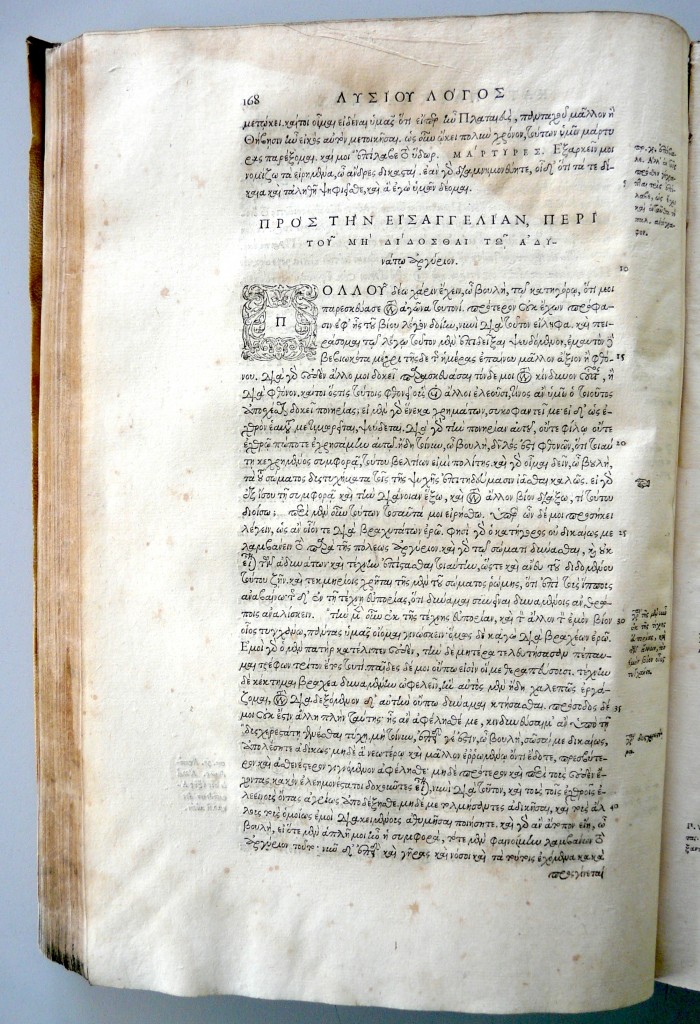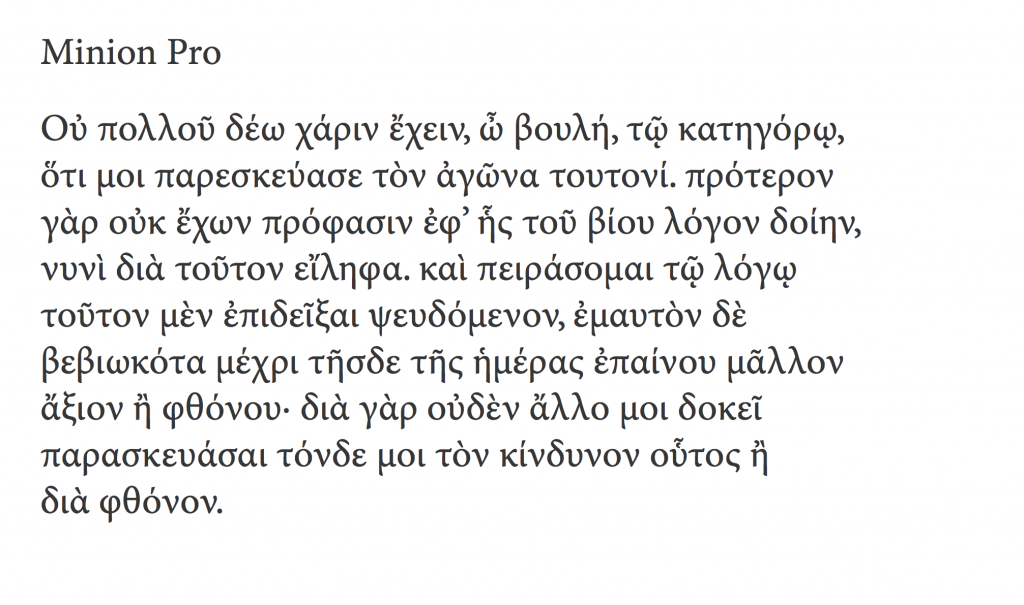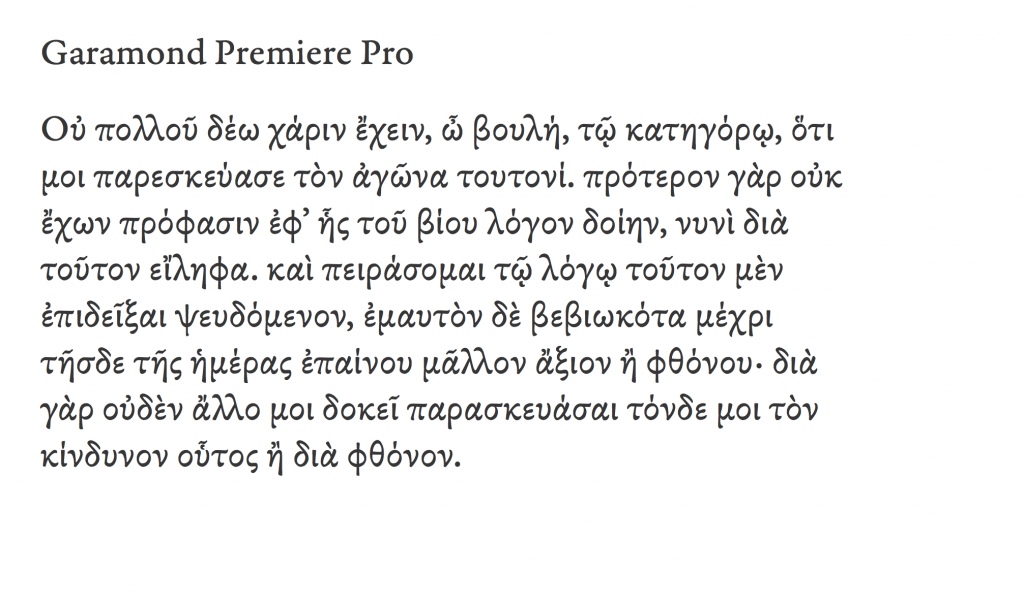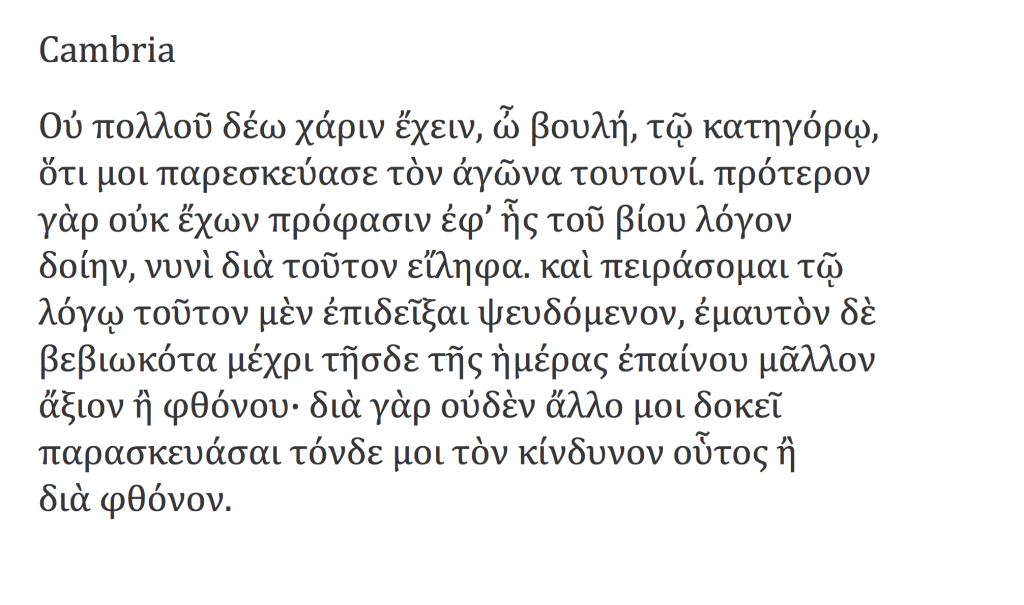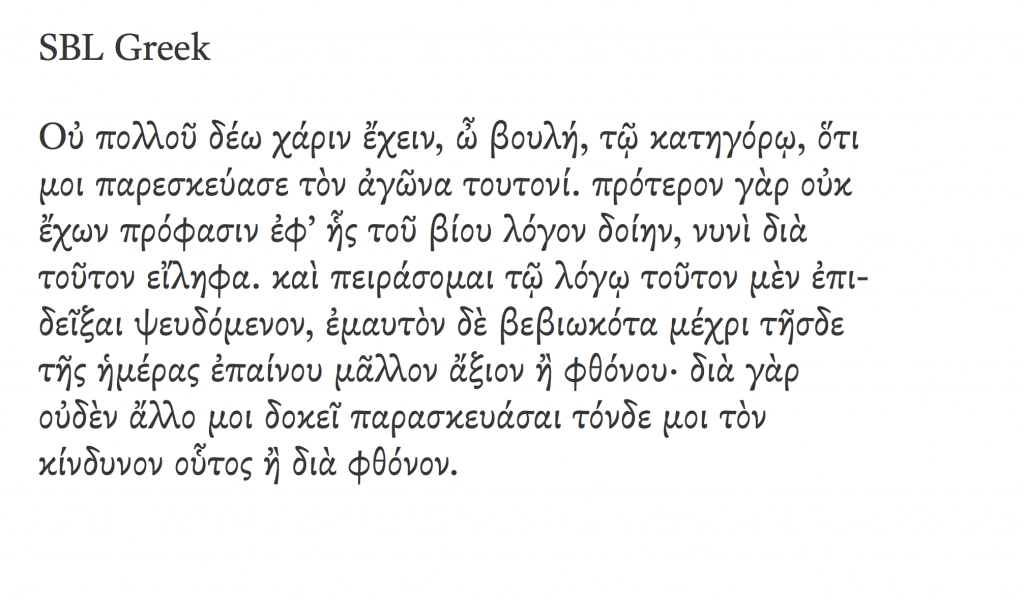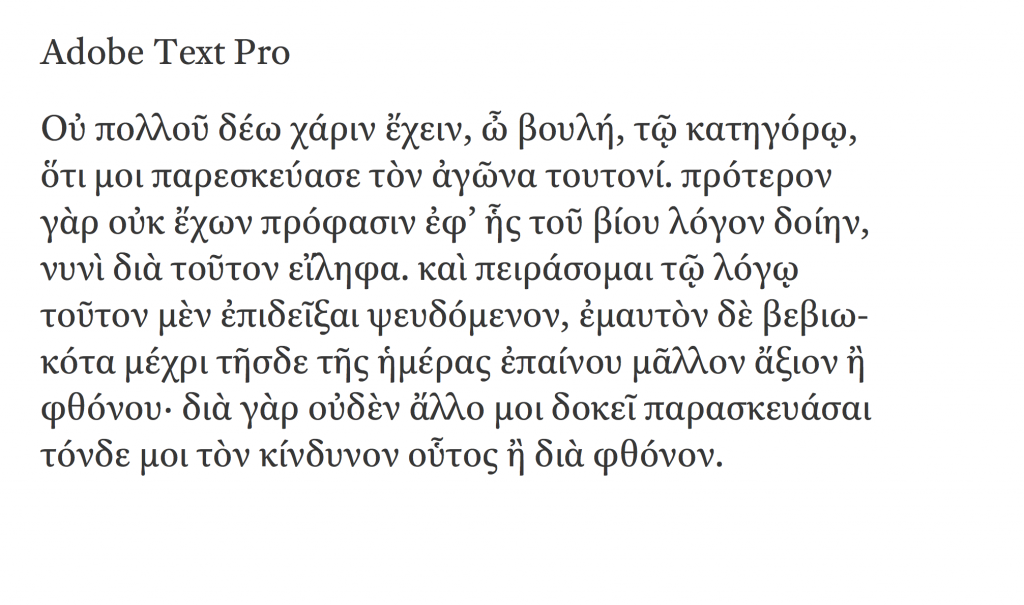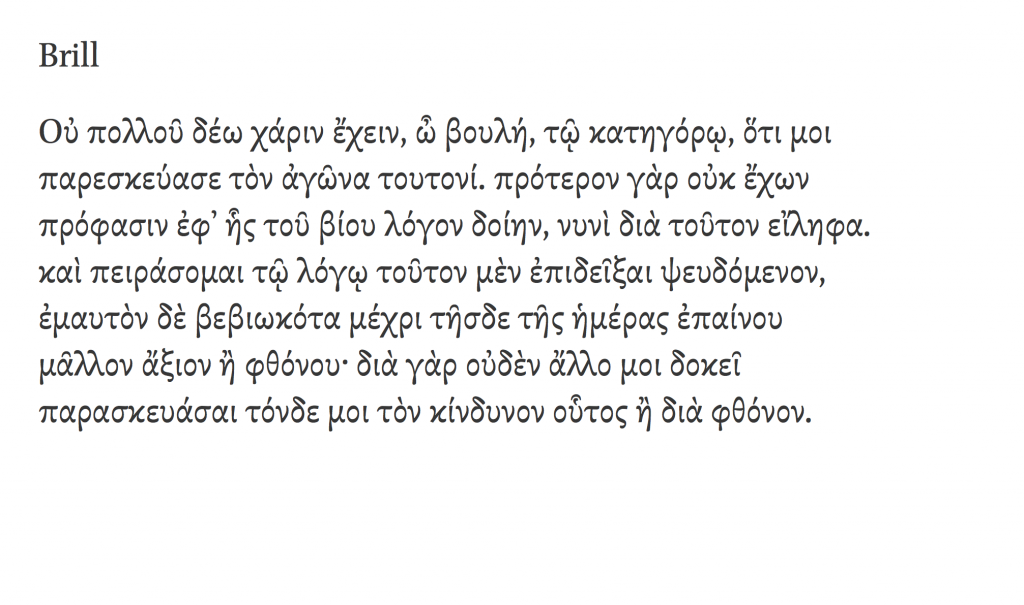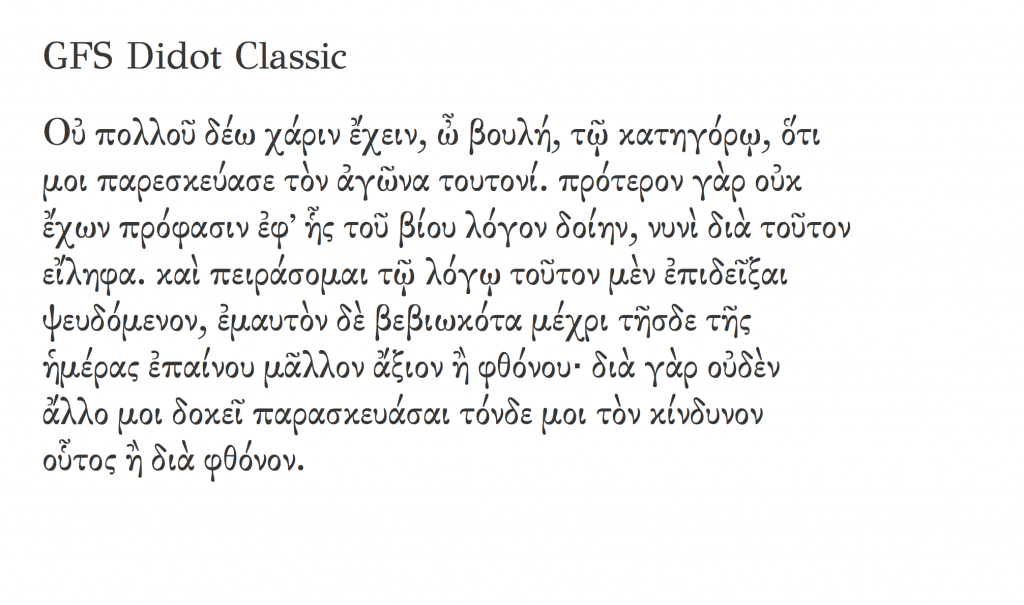[n.b. This is a pre-publication version of the text that appeared eventually in Language, Culture, Type in 2002. The text was written in 1998 for the third issue of Type, the ATypI journal. Type no. 3 never materialised, and the text was later edited again for inclusion in the book published by ATypI with the occasion of the Bukva:raz competition (2001).
In 1998 – even in 2000, when the second edit took place – the state of Greek fonts internationally was very different that nearly fifteen years later. Only Adobe had made significant original contributions, and designers were just beginning to be interested in the challenges of Greek typeface design. It is worth keeping these points in mind when reading the text.]
At the 1997 ATypI Conference at Reading I gave a talk with the title ‘Typography and the Greek language: designing typefaces in a cultural context.’ The inspiration for that talk was a discussion with Christopher Burke on designing typefaces for a script one is not linguistically familiar with. My position was that knowledge and use of a language is not a prerequisite for understanding the script to a very high, if though not conclusive, degree. In other words, although a ‘typographically attuned’ native user should test a design in real circumstances, any designer could, with the right preparation and monitoring, produce competent typefaces. This position was based on my understanding of the decisions a designer must make in designing a Greek typeface. I should add that this argument had two weak points: one, it was based on a small amount of personal experience in type design and a lot of intuition, rather than research; and, two, it was quite possible that, as a Greek, I was making the ‘right’ choices by default. Since 1997, my own work and that of other designers–both Greeks and non-Greeks–proved me right.
The last few years saw multilingual typography literally explode. An obvious arena was the broader European region: the Amsterdam Treaty of 1997 which, at the same time as bringing the European Union closer to integration on a number of fields, marked a heightening of awareness in cultural characteristics, down to an explicit statement of support for dialects and local script variations. Furthermore, the assignment of candidate-for-entry status to several countries in central and eastern Europe, and the tightening of relationships with other countries in the region, foregrounded not only the requirements of the extended Latin script, but the different flavours of the Cyrillic script in use within the broader European area. In this context, the Greek script is a relatively minor, if indispensable, player. However, in a reflection of its history in the last five centuries, there is a huge interest for Greek typography from outside the boundaries of the Greek Statestate. There are considerable Hellenic communities in Europe, North America, and Australia; a significant number of academics working on ancient, Byzantine, and modern Greek; and an important worldwide market for bilingual ecclesiastical texts.
[1] Typeface by the Spaniard Arnaldo Guillen de Brocar. This is one of the three main strands of early Greek type styles. Despite its simplicity and clarity, it fell victim to the commercial success of the Aldine model.[2] Typeface by Demetrios Damilas. This strand of early Greek type styles, in some ways a stylistic precursor to de Brocar’s, combined regularity with fluidity without indulging in over-complexity.
Despite sizable gaps in published research, the development of the Greek typographic script up to the twentieth century is well established, at least for the non-historian. The twentieth century, on the other hand, is not as well documented, and even less well researched–a regrettable fact, since it is a far more volatile and interesting period for Greek typography. Here, I will very briefly go over a few key contributions to Greek type design up to the end of the nineteenth century, before expanding on more recent developments.
Greek letterforms up to the fifteenth century, in three points
• Varied, but clearly related, inscriptional and scribal strands of development are established, spanning all the way from pre-classical times through the Hellenistic years and the ascendancy of Orthodox Byzantium. Inscriptional letters were not cut at the larger sizes common in Imperial Rome; the development of Byzantine hagiographical and secular lettering did not follow the logic of the brush-stroke construction as outlined by Catich in his Origin of the Serif.
• An uncial hand developed for writing on softer materials, which branched into official and vernacular varieties, the latter with a strong cursive character. Such hands were increasingly adopted by the mercantile classes, secular writers, and non-patristic ecclesiastical writers. Letters from older hands were used for versals and titles.
• After the Sack sack of Constantinople in 1204 by the fourth Crusade, the western, largely Venetian, occupation of many lands, particularly Crete and Cyprus, facilitated the migration of Greek scribes to the Italian peninsula. This movement turned into a flood after the Fall fall of Constantinople in 1453 to the Ottoman Turks. It was the cursive hand that these scribes brought to the West, and put to use as tutors, editors, and printers.
The first Greek typefaces
The first printers to cast Greek type used the hands of Italian Humanists humanists as models. Typefaces of this group tend to have upright letterforms, with nearly circular counters, and monoline strokes with occasionally bulging or tapering terminals. There are few ligatures, and letterforms are positioned within a clearly defined vertical band–in other words, there is minimal kerning. Although some letterforms were consistently troublesome for western punch-cutters, texts are easily readable and the texture of the page is generally even. This style reached its zenith in the typeface by the Spaniard Arnaldo Guillen de Brocar, [Fig. 1], famously used in the Complutensian Polyglot Bible.
Scribal models for Greek typefaces were not as established as for Latin ones, where the varieties of blackletter were dominant in patristic and ecclesiastical texts, and the early Humanists’ humanists’ version of littera antiqua were standard in classical texts and treatises. Despite the considerable involvement of non-Greek scholars in–mostly Venetian and Florentine–publishing enterprises, the refugee scribes and scholars had significant authorial and editorial presence, even when they did not assume the role of publisher or printer. It is not difficult to imagine that their manuscripts would be seen as fitting models for the cutting of new typefaces.
This first style of types modelled on the hands of the Greek refugees is exemplified by the type of Demetrios Damilas, which appeared in 1476. [Fig. 2] Each letterform is clearly differentiated, although there are more ligatures and abbreviations. Some regularity and circularity has been traded for a closer correspondence to the variety and vigour of energetic handwriting. One could say that these types mirror the scribe’s familiarity with the letterforms. The strong distinction between minuscules for text and capitals for versals or titles must have made it easier for printers to use capitals from different typefaces, not to mention borrowing what could be used from a Latin fount.1
[3] The hand of the Greek scribe Immanuel Rhusotas, which Aldus used as a model for Griffo to cut his Greek types. The fluidity is characteristic of a proficient scribe’s hand.[4] First Greek typeface by Aldus Manutius. The decision to provide a sufficient number of ligatures, contractions and abbreviations to replicate the texture of the handwritten text would burden the Greek typographic script with undesirable complexity for centuries.
The turning point for Greek types is 1495, the year Aldus Manutius published his first Greek text. Technical considerations aside,2 Aldus’s importance lies in his choice to follow the hand of the Greek scribe Immanuel Rhusotas [Fig. 3] in all its complexity. This necessitated a huge number of contractions, ligatures, and alternate sorts. [Fig. 4] His Aldus’s three subsequent typefaces were essentially attempts to simplify the design and eliminate ligatures and contractions. Unfortunately, and to the regret of generations of compositors, it would take a couple of centuries for punchcutters of Greek to take serious steps in turning a scribal script into a typographical one suitable for typesetting by hand.3
The typefaces that mirrored the handwriting style of contemporary scholars must have contributed to the commercial success of the Aldine editions as much as their novel format, and Aldus’s drive to publish Aristotle’s works. The result was that the style became the accepted face of printed Greek erudition, and was imitated widely, in complexity comparable to the originals.
We should note that the prominence of the Aldine style eclipsed other alternatives, most notably the practically contemporary design of Zacharias Kalliergis. [Fig. 5] This typeface has wider spacing, more open counters, and curved strokes that develop without crowding or closing in on themselves. Altogether more space is allowed for the elaboration of strokes–and, despite being based on a scribal hand, there are concessions to typographical necessity. Kalliergis’ typeface influenced some later designs, but its legacy was not lasting; a regrettable development by any measure.
[5] Typeface of Zacharias Kalliergis. Another victim of Aldus’ business acumen, this was probably the most promising of all the strands of early Greek type: It is fluid but uncomplicated, elegant yet susceptible to regularisation.
In the 1540s Claude Garamond cut a Greek typeface [Fig. 6a & 6b] in three sizes drawing on the Aldine spirit, but this time based on the hand of another Greek scribe, Angelos Vergikios. The types are more open and upright, and strokes flow easily into one another. One could say that the smoothness of the curves and the transitions from one letter to the next bring to mind the shift in the French interpretations of Griffo’s italics. To the compositors’ continuing despair, the founts were equipped with hundreds of ligatures and contractions. Garamond’s typefaces was were an immediate and long-lasting success: printers hastened to secure copies or close approximations, and the style dominated Greek typefaces well into the 18th century.
[6a] The writing of the scribe Angelos Vergikios. Despite its elegance, this hand has all the marks of a script that is unsuitable for conversion to a typographic alphabet.
For the two centuries after Garamond, the main development was the inevitable abolishment of most of the ligatures and contractions. The issue was not simply one of just not using the extra sorts; if a punch-cutter had intended a typeface with, for example, a double gamma ligature, the possibility of two single gamma sorts side-by-side would not have been anticipated. If we take into account the extent to which typefaces relied on ligatures and alternate sorts, simply omitting these features would amputate truncate the design. It was not until 1756 that Alexander Wilson cut a successful typeface that followed the established models while doing away with all but the most basic ligatures and contractions. [Fig. 7a & 7b] The new trend did not catch on as easily as compositors might have hoped, but eventually Greek typefaces were liberated from the more complex scribal remnants.
[7a] Alexander Wilson’s Greek typeface for the Foulis Press.[7b] Wilson’s typeface digitised by Matthew Carter (from a 1995 specimen).
The eighteenth century saw printers like Baskerville and Bodoni transplanting elements from the writing masters’ style and the Modern types to their Greeks, with, on the whole, unfortunate results.4 An inclined variety with some distinct traces of Bodoni’s style was developed by German printers for textbooks of Greek authors; the style survives to this day.
However, one of the most important figures from the early 19th century was the Frenchman Ambroise Firmin Didot, a fervent philhellene and supporter of the early attempts to establish printing on Greek soil in Greece (Didot trained a Greek printer and donated one of the first presses to operate on liberated Greek soil). His types, which dominated Italy as well as, eventually, the lands of the emerging Greek Statestate, are a distant descendants of the grecs-du-roi, but have evolved a consistent style of their own. [Fig. 8] The upright stance and relative thickness of the strokes impart solidity, while the ductal character conveys liveliness and speed. Eventually, the Didot style would prove more resilient than the Bodoni-clones, providing the basis for what became the most widely used typeface this in the twentieth century within Greece.
[8] A Greek by Didot, dating from 1790. Note the two forms of tau: the ascending one survives only in scribal forms today. Later interpretations of the style would tighten the curves and eliminate some of the mannerisms (like the flick at the bottom of the rho, and the overly pointed delta).[9] Richard Porson’s typeface, based on the hand of the Hellenist Richard Porson. Note the tear-drop terminals of vertical strokes, the lunate epsilon, the ‘headless’ lambda, and the concave perispomeni.
A completely different strand was initiated by the Cambridge Hellenist Richard Porson, who designed a typeface based on his own handwriting, cut by Richard Austin in 1806 [Fig. 9] The design was a radical departure from contemporary styles: the curves are simplified and the structure and alignment of characters more regularised. The modulation of the strokes is more consistent, and there are some new interpretations, like the lunate epsilon (present in several manuscripts, most commonly as part of ligatures), the kappa, and the simpler perispomeni. The terminals are varied: some taper, some end in drop-like bulbs, and some are sheared. The design is somewhat inconsistent in the balancing of white regions, both in closed counters and around open characters like the lambda. Appropriately for this style, there were no ligatures or contractions. Porson’s design showed the way forward for the next generation of Greek typefaces, re-stating the case for abandoning the grecs-du-roi influence and regularising the strokes of letterforms. It was widely copied (and modified) and still enjoys considerable success, albeit within Greece only for shorter runs of text.
The twentieth century
Although typefoundries existed since from the very first years of the modern Greek state, the turn of the twentieth century saw Greece importing most of its printing equipment, as well as essentially all the models for text typefaces, from Europe. We can identify two main strands, : an upright style drawing on Didot’s Greeks, and an inclined style with direct references to German typefounders. Notwithstanding the vicissitudes of typographic fashion, upright and inclined typefaces were considered equal for text material.
From around 1910 onwards, Lanston Monotype and Mergenthaler Linotype began to make Greek typefaces available for machine composition. The involvement of these companies was instrumental in clarifying character sets, especially in relation to alternate forms (primarily the alpha, beta, epsilon, theta, kappa, pi, rho, and phi). Another, more elementary, influence of Monotype and Linotype was the complete redefinition of the relationship between primary and secondary typefaces: until that point, Greek typesetters used spacing between letters to signify emphasis in a text. Less frequently, an alternate typeface might be used. Monotype and Linotype shifted inclined Greeks towards a role equivalent to italics in Latin typography, a decision that must have been driven by marketing as much as technical reasons. Both adopted the Didot style for their uprights; and Monotype’s Series 90 became the definitive text typeface of the twentieth century. Numerous–and hugely varied in quality–digital versions are still very popular for literature, while some lower-run or luxurious editions are typeset with the hot-metal versions. An inclined typeface with clear German roots and few exact design correlations with the Didot style, which until that time was a text typeface in its own right, became the Series 91, the designated secondary italic.
Although types were cut in Greece throughout the period of mechanical typesetting, any original designs were limited to display typefaces; very few typefaces used for text did not failed to conform to either of the Didot or the [German] inclined paradigm. One common characteristic common to both of hand-setting type specimens from the early part of the century and the surviving specimens from pre-digital phototypesetters is the very narrow selection of text typefaces, and the relative profusion of display designs. Perhaps not surprisingly, few of the latter have survived the test of time.
[10] Monotype’s Series 90 and 91 Greeks. The surviving names for the two styles are indicative: the Didot style is still called aplá, which means ‘simple’ (but also, in Greek vernacular, ‘default’) and the cursive variation of the inclined types was until the early 1990s called Lipsías, which means ‘from Leipzig.’[11] Victor Scholderer’s New Hellenic in Monotype’s digital version, with the scribal form of Omega. Below it, a local version of questionable pedigree. Note the xi, final sigma, Theta, and Psi.
In 1927, Victor Scholderer designed the New Hellenic for Monotype. [Fig. 11] With some modifications, this has enjoyed moderate success outside Greece, and rather more within, where it has also had the honourable role of a variation having been used in primary school first readers for nearly three decades.
In the years up to the Second World War, most attempts at new Greek typefaces by non-Greeks–admittedly not numerous, but some by highly credited designers like Eric Gill and Jan van Krimpen–were (mis)conceived, and failed to even dent the hegemony of the Didot style. However, this did not open up the road to Greek designers: although Greek printers relied heavily on foundry type which that was generally produced locally, any originality in domestic production continued to be limited to display types.
The fifties changed all that. Greece was becoming an industrialized country with a rapidly expanding urban population, so it’s no surprise to see new designs for the emerging middle middle-class markets. The Gill Sans family [Fig. 12] designed by the Monotype drawing office was widely imitated, and, together with a small number of other sans serifs, provided the workhorses of the periodical press and advertising of the time.
[12] Monotype’s digital Gill Sans (upper pair) is seriously compromised by the alpha, gamma, zeta, lamda, mu, tau, chi, psi, and sigma. The pirated version (one of many) improves somewhat on the alpha, zeta, and final sigma, but is wide off the mark in its beta, gamma, theta, lambda, tau, phi, and chi. most of which are plainly wrong. Note also the Xi, with the vertical joining stroke. Different forms are juxtaposed below.[13a] Different versions of Times Greek with associated italics. Some italic fonts are little more than slanted, compressed versions of the uprights. The alternate forms of letters (e.g. the alpha, gamma, kappa, upsilon, phi, psi) suggest one possible route for differentiating effectively between the primary and secondary fonts.[13b] Different alphas from successive versions of Times Greek typefaces. The alpha is the most common letter in Greek texts, and the size and shape of its counter will have a profound effect on the texture of typeset text. Ironing out the corner in the counter of the alpha precipitated a straightening of the right half of the typeform into a single vertical stroke; together these constitute one of the most unfortunate developments in Greek type design.
The other major family of the fifties was Times Greek. [Fig. 13a & 13b] Capitals excepted, the Greek versions share little with the Latin ones. Regardless, the ubiquity of Times Greek (in all its guises) in the last thirty-odd years, both within and outside Greece, is undeniable, if far from deservingdeserved. We must keep in mind that Latin typefaces of the time were very much influenced by the regularising approach of the period. However, this then in favor; this approach, however, was primarily implemented in new designs or interpretations of fin-dude-siécle sans serifs. It is questionable whether the Times family was a good choice for such treatment. Applying a 1950s approach to the style of a 1930s typeface (with sixteenth sixteenth-century roots) was inauspicious for Times Greek. The homogenised counters and normalised typeform widths with add-on scribal flourishes and terminals leave a lot to be desired, and the unresolved stress angles and compressed or extended counters testify to a program that failed to adapt conclusively the Latin original’s characteristics to the Greek.
[15] Some badly designed Greek ‘Bodonis’.
The early seventies saw the arrival of the Greek Optima, which was to carve its own niche in Greek magazine publishing, and, more importantly, one of the most influential designs of the post-junta period: the Greek Helvetica. [Fig. 14] This was one of the first new Greek typeface designed directly for phototypesetting; on the whole, the few available phototypes had been re-issues of hot-metal designs. Helvetica went hand-in-hand with the new style in magazine and advertising, if with a few years’ delay from the rest of Europe. Through mainly the periodical press, Helvetica became part and parcel of the new, ‘cleaner,’ European aesthetic promoted to urban readers from that time onwards well into the next decade. It is clear that Matthew Carter, who designed these fonts, was asked to produce typefaces that ‘looked like the [western] Latin [western] ones,’ an understandable request in the political and cultural context of early 1970s Greece. However, the serifed typefaces of the group developed at the time (Baskerville, Century Schoolbook, and Souvenir) revealed problems with this approach that trouble Greek typefaces to this day.
[14] Common Helvetica and Optima versions. The bottom example of Optima is particularly poor.
All in all, however, the seventies were not years of typographical revolution in Greece. To this contributed not only the political turmoil of the junta of 1967–74 and the subsequent drive to rebuild democracy, but, perhaps more importantly, the fact that many publishing projects were adequately covered by existing technology. Although many magazines adopted offset technology, by far the most greatest number of book publishers continued to use hot-metal printing. As the book market was characterized by a large number of small publishers producing modest print runs, printers had little to gain by investing in the new technology. In that light, the lack of available typefaces was not seen as severely limiting. All this was to change in the early eighties.
[16] Greek glyphs from Adobe’s MyriadPro, MinionPro, and WarnockPro OpenType fonts.
In 1981 Greece became a full member of the–then–what was then the EEC. The international boom of the decade coincided with the coming-of-age of the urban middle classes, who now were affluent enough to afford, but not mature enough to refuse, the extrovert consumerism of American culture. The combination of phototypesetting maturing to digital formats, and the adoption of the monotonic system for Modern Greek in early 1982, which allowed professional typesetters to be replaced by keyboard operators, drove an increasing transfer of hot-metal and early phototypes to digital phototypesetting. As with Latin typefaces, as often as not such transfers produced inferior results on the printed page. This tendency to transfer existing designs into digital formats took on a new angle from the mid-eighties, with dramatic consequences. The gradual adoption of 8-bit Greek fonts with character sets based on ISO 8859–7, Win 1253, or Mac/OS Greek (by far the worse of the three) was the single most important factor in encouraging font piracy by local designers. A general disregard for international legal standards and accepted practice did not help, as nor did not a desire, typical of the period, desire to make a quick profit. The explosion of the periodical and promotional fields fuelled this phenomenon even further. Greece filled with service bureaus where attention to detail in typesetting and quality in print production were sacrificed to turnover rates and low costs. These companies supported and recycled the graduates of numerous new graphic design schools where depth in design education was rarely, if ever, achieved.
The last decade saw an improvement in some areas. Many designers moved on to multimedia and web design, where it is seems easier to justify a pay check to reluctant clients. Thankfully some–a few–clients have begun to recognize the effort invested in a typeface design, and are willing to seek work of a higher quality. There also seem to be some schools that attach more emphasis to quality in design education, although how many of those subscribe to Hyphen remains to be seen. At the same time, many typefaces in circulation are in breach of copyright or design patents. The result of all the above is that many new Greek typefaces by Greek designers betray a lack of understanding of fundamental aspects of Greek typography, the basic shape of Greek typeforms, and good typesetting. The last few years have witnessed an overwhelming proliferation of designs, ranging from the ever-present hacking of Latin typefaces to a few serious efforts. [Fig. 15] The Greek market is in the process of discovering the made-to-order typeface, advertisers are beginning to realize the potential of an eye-catching design, and, as is usual in similar circumstances, several people have become instant experts. Designers who trained–as opposed to ‘were educated in design’–from the last years of the eighties onwards enjoy a more open communication with activities in Europe and the United States, and are now a significant part of the professionally active design community. However, for every original typeface design there is still a hacker trying to make some easy money.
In the meantime, a number of expanded character sets have been developed to address the demand for multilingual and multi-script support. Microsoft was the first significant source of such a set (with WGL4), but from a design perspective are not exceptional; Adobe’s later OpenType fonts are much more notable, [Fig. 16], and include one extensive polytonic typeface which I hope may will hopefully dent the ubiquity of the several versions of Times Greek used by classicists worldwide. As expected, the type designers employed by such companies in most cases cannot read Greek, and may have a very patchy–if any– knowledge –if any–of the relevant Greek history. The problem therefore facing any designer, Greek and or non-Greek, is whether a new design respects the script’s history and design characteristics, while developing the typographic morphology consistently and with originality.
Conclusion
It is an irony of history that while so many people were studying classical Greek, the Greek people were either under foreign occupation, or struggling to mature as a state and a nation. Partly because of this, many Greeks developed an all-too-easy rejection of foreign intervention or example; and many foreign affairs that affected Greece negatively were condemned as if political expediencies were tinged with anti-Hellenic bias. Greeks have often accused non-Greeks of corrupting our cultural inheritance, just as foreigners have accused Greeks of negligence in caring for that inheritance. The truth, as usual, lies somewhere in between. Typeface design has not escaped this attitude, which was aided by the overwhelming dominance of the typesetting equipment market by international companies. Despite protestations that it is very difficult, if not impossible, for a non-Greek to capture the ‘essence’ of Greek typeforms, the fact remains that, until a few years ago, it was mostly non-Greeks who designed and produced Greek typefaces. With hindsight, and in light of recent work, we would have to concede that they did a decent job.
Writing in a different context, Richard Clogg wrote that: ‘… “Greekness” is something that a person is born with and can no more easily be lost than it can be acquired by those of not Greek ancestry’.5 Clogg makes a case for language not being the defining criterion; my experience of non-Greek type designers seems to support that, at least to a considerable degree in the design process. Good typefaces are created through a combination of a knowledge of the traditional forms of the script, and an immersion in dialogue with existing designs, whatever format this interface may take. I would like to think that a well-informed designer with a talent for identifying formal consistencies and distinctions in unfamiliar typeforms can go a long way in Greek type design, without worrying too much about her or his lack or misunderstanding of ‘Greekness’.

